Norway are one of the great giants of women’s football. Along with the United States and Germany, they are the only national team to have won all three major international women’s football tournaments — the World Cup, the Olympics and the tournament of their confederation (the EUROs, in the case of the Norwegians). Moreover, they go into the 2023 edition of the Women’s World Cup as one of the favourites; not only do they have one of the most talented squads in the competition, but they did not lose a single match in Group F of the qualifiers for the competition.
In this edition of the tournament, Norway will share Group A with the Philippines, New Zealand and Switzerland — and the Norwegians are the favourites among them all due to their experience at international level and their ability to adopt different approaches to suit different opponents.
So, here, we take a look at the Norwegian national team under the tactics of Hege Riise and how they have managed to become one of the best teams in the world.
Predicted starting XI

Norway are a team that have used several players in their recent games, but they have a well-defined style of play with clear roles for each player in the squad, so Riise can use different players according to the opposition they face, but ensuring that her game plan remains dynamic at every phase.
Aurora Mikalsen is expected to be the starting goalkeeper. Although she has had an injury that has kept her off the pitch for the past few months, she will be fit for the World Cup and has been the coach’s choice during Norway’s recent friendlies. However, it is also a positive for the team to have had Sunniva Skoglund and Guro Pettersen recently and both have made a good impression.
In defence, Norway are expected to use a regular back four of Tuva Hansen, Maren Mjelde, Mathilde Harviken and Marit Lund. All are very experienced players who know each other and can hold up the back line very well. However, there could also be changes at full-back at times, with Thea Bejelde having played right-back and Tuva Hansen having played left-back.
In the middle of the pitch, Vilde Bøe Risa is one of the most important pieces of the team as DM. She is in charge of keeping her block balanced and also distributes to connect with her teammates. She is likely to be joined by Emilie Haavi on the left and Frida Maanum on the right, with the latter being a very important player in the system for her constant arrivals in the opposition box. Further forward, Guro Reiten and Caroline Graham Hansen, both of whom are maintaining a very good level, could be the team’s starting wingers.
Up front, Ada Hegerberg is the favourite to be the starter, but this is a position where Norway has several young players of very good level, so the pieces could alternate as the matches go by.

Attacking phase
Norway are a much more dynamic and aggressive team than a team that controls the tempo of the game. In fact, they do not tend to dominate their opponents with possession, but can vary their approach considerably according to the team they face — in this respect, Hege Riise stands out as a coach with a very good interpretation of opponents’ ideas in order to design a specific game plan for each match and realise a good version of her players.
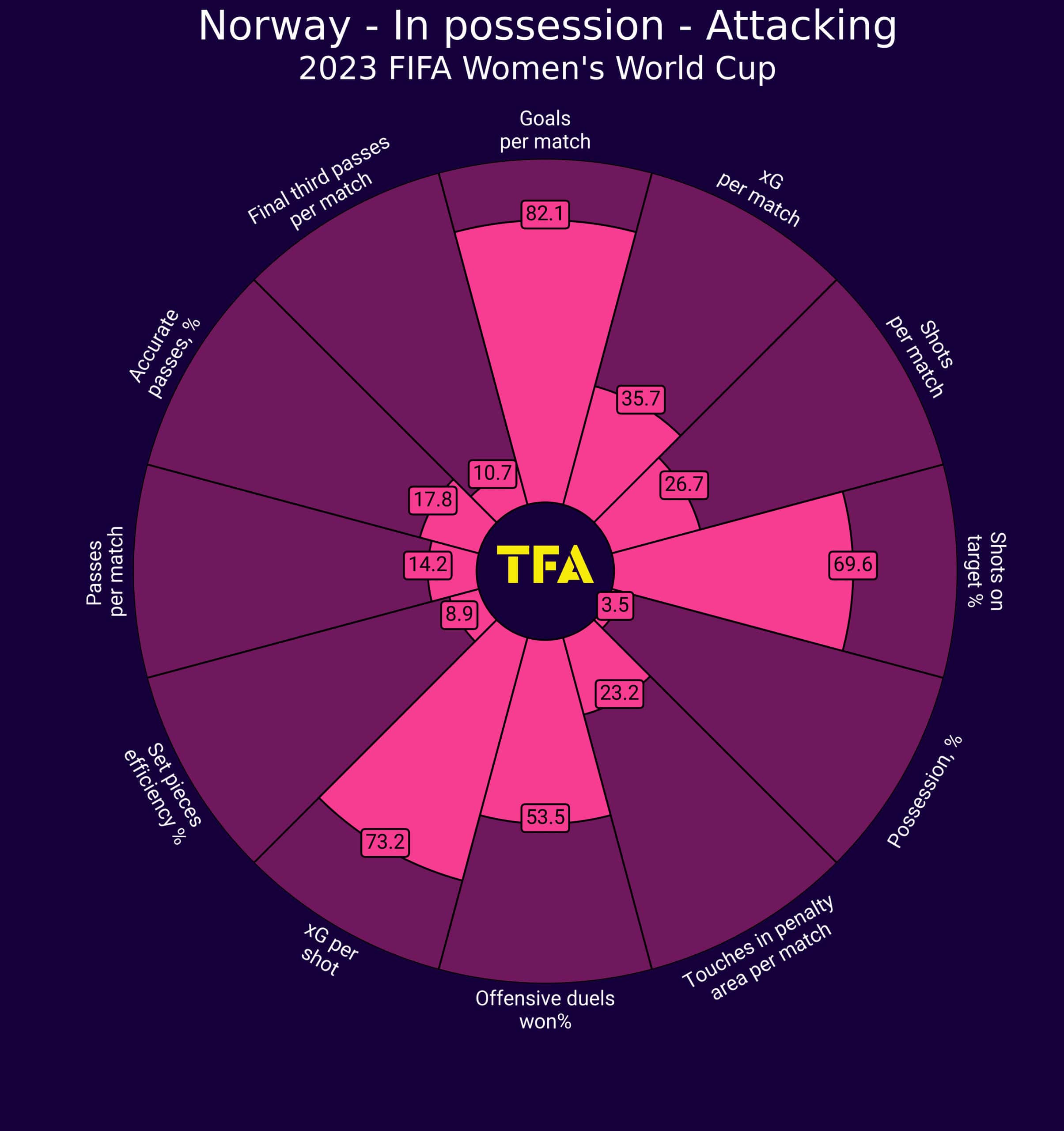
In possession, the Norway team looks to move forward quickly and break the opposition’s lines frequently. They are not looking to circulate side-to-side patiently to create space in the opposition block, but rather to exploit the progressive passing range of centre-backs and defensive midfielders to connect with a player behind the opposition midfield or directly activate the wingers into space on the outside.
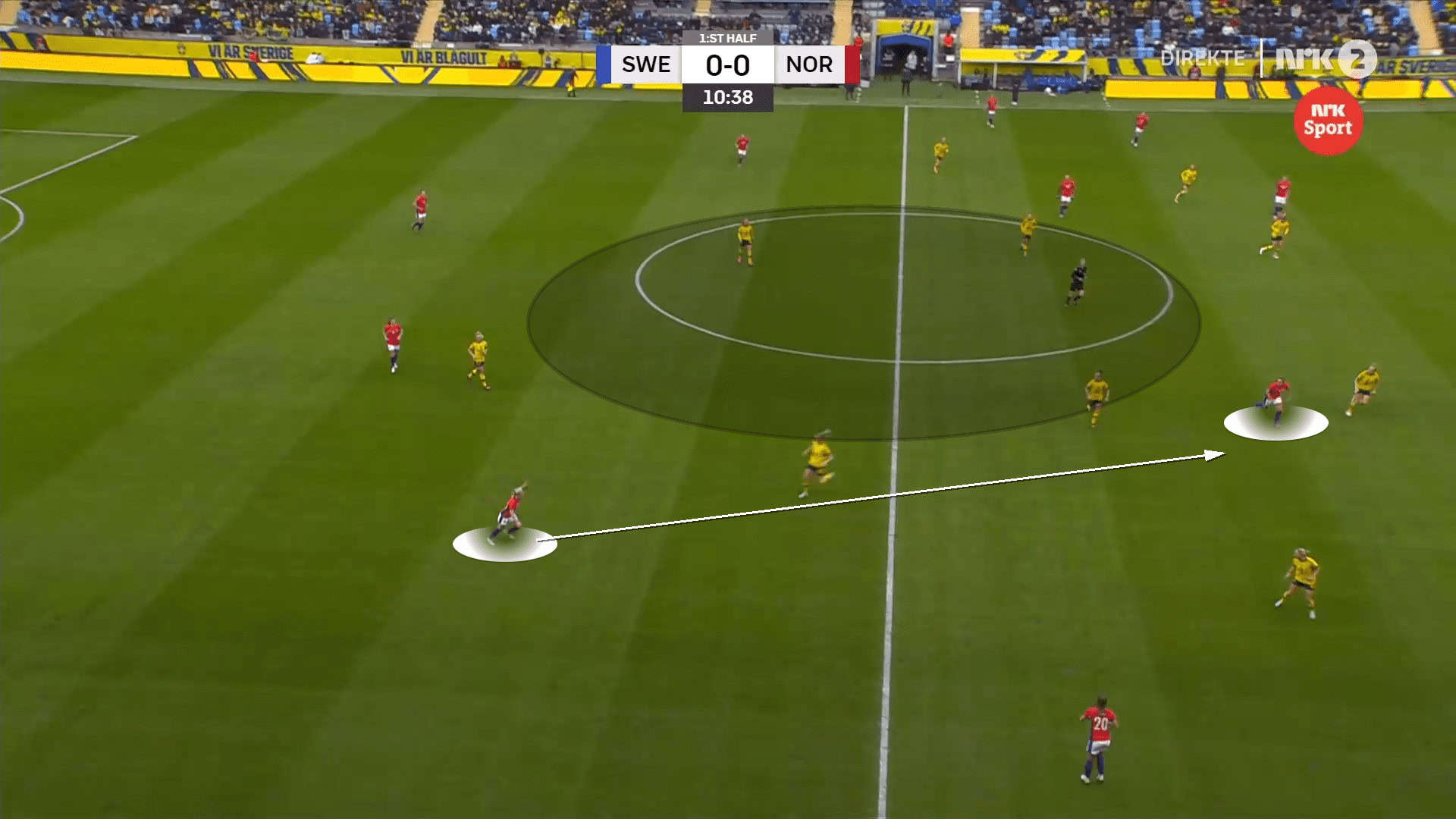
However, the team takes big risks to carry out their idea; at times, they free the base of the play and create big spaces through which the opposition can progress very quickly if they win the ball back. Both central midfielders sometimes have the same function of attacking the spaces behind the opposition midfield and do not position themselves in a staggered way to create a short passing line and maintain a better balance.
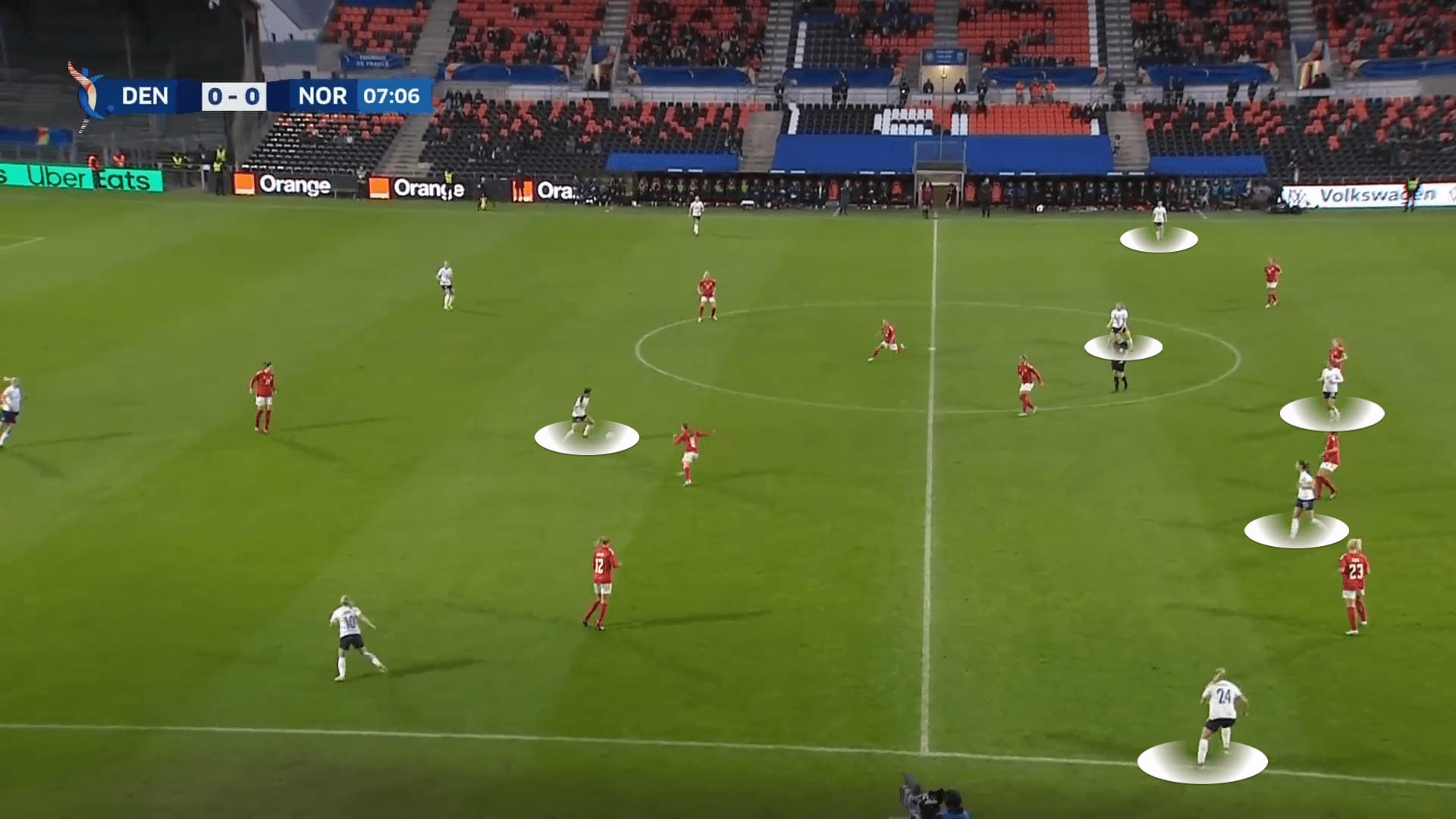
This also means that, at times, when the holding midfielder receives a pass from the centre-backs and turns, she has no players close to her to link up with and all her progressive passing options are very risky. In general, there is a lot of room for improvement in the timing that Frida Maanum and Emilie Haavi usually have to make unmarked moves and attack space in the opposition half.
However, when the team is able to better interpret periods of possession and exploit spaces in the opposing block, they often create attacking dynamics with the use of third-man concepts that allow them to progress and create dangerous chances of high quality. In this sense, Vilde Bøe Risa’s range of progressive passing is key and the situational awareness of the players close to her (CF moves back to create passing lanes, movement of the intermediate player to receive, wingers or CM on weak side runs behind the defensive line, etc.) are remarkable.
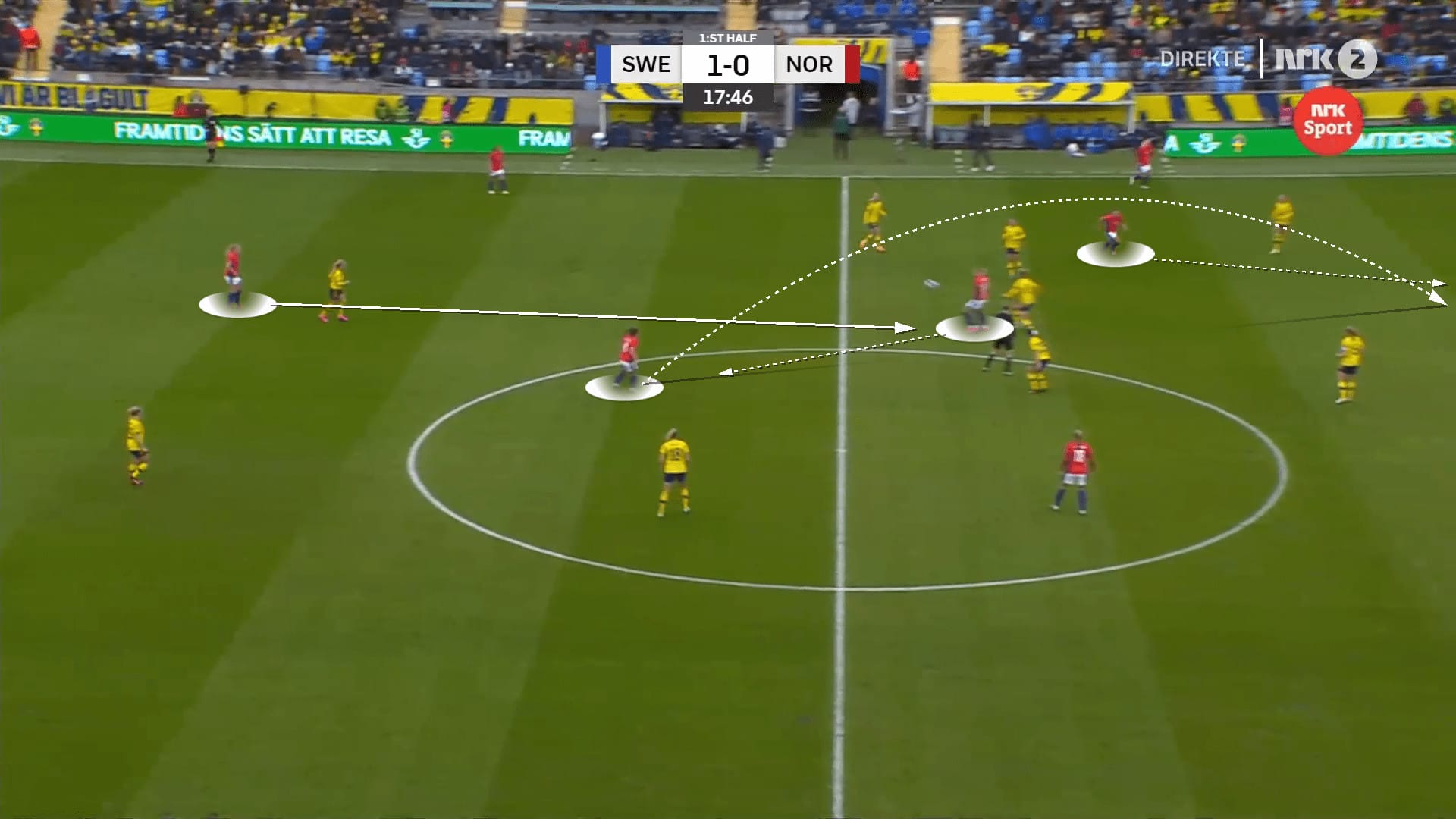
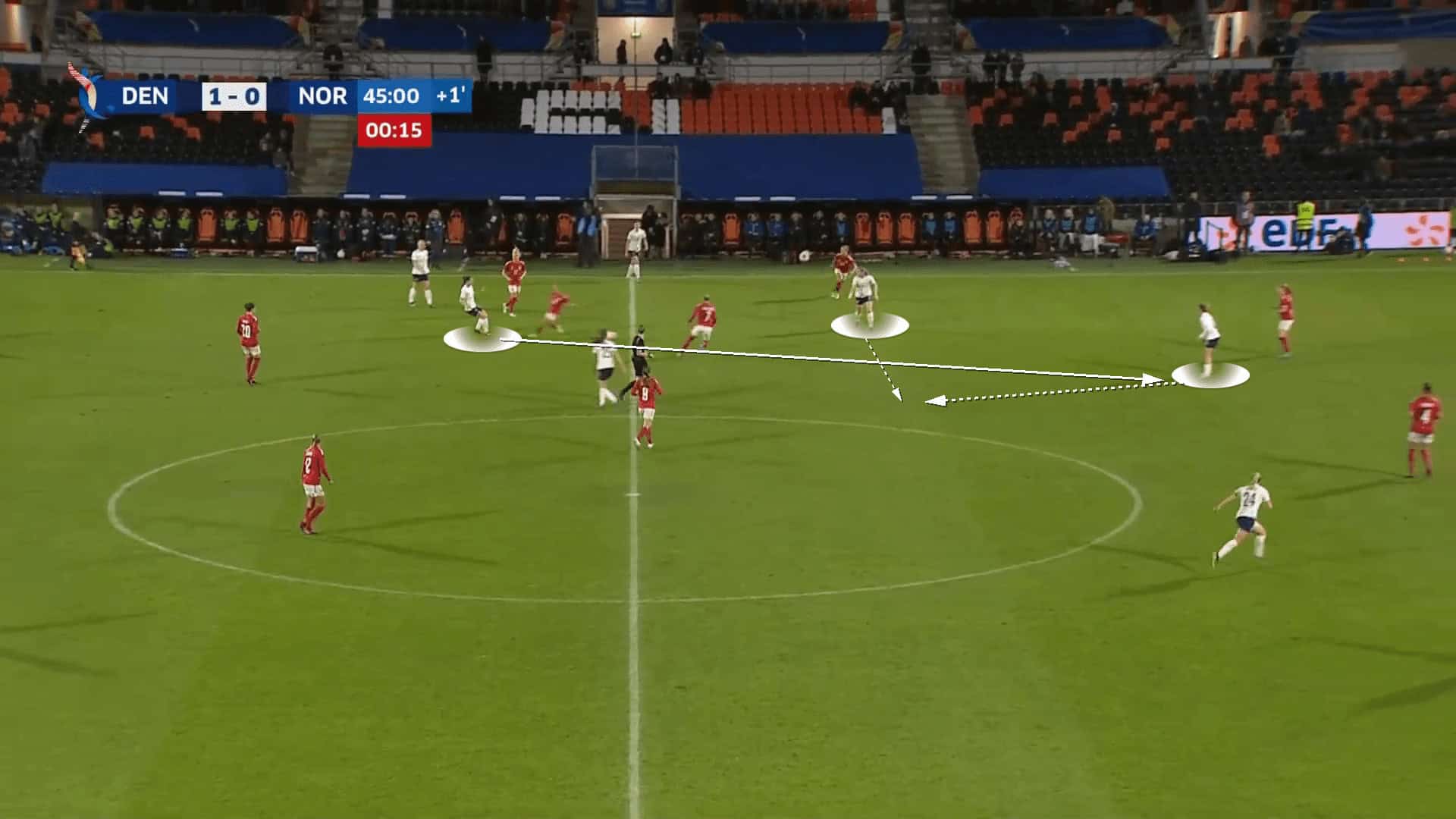
Norway are not a team that gain and exploit too many advantages in their build-up phase. At times, they are vulnerable to high pressure and manage to lose the ball in very dangerous situations. As such, they look to progress quickly through long, tense passing and not always connecting with players behind the front line and moving forward in a staggered fashion.
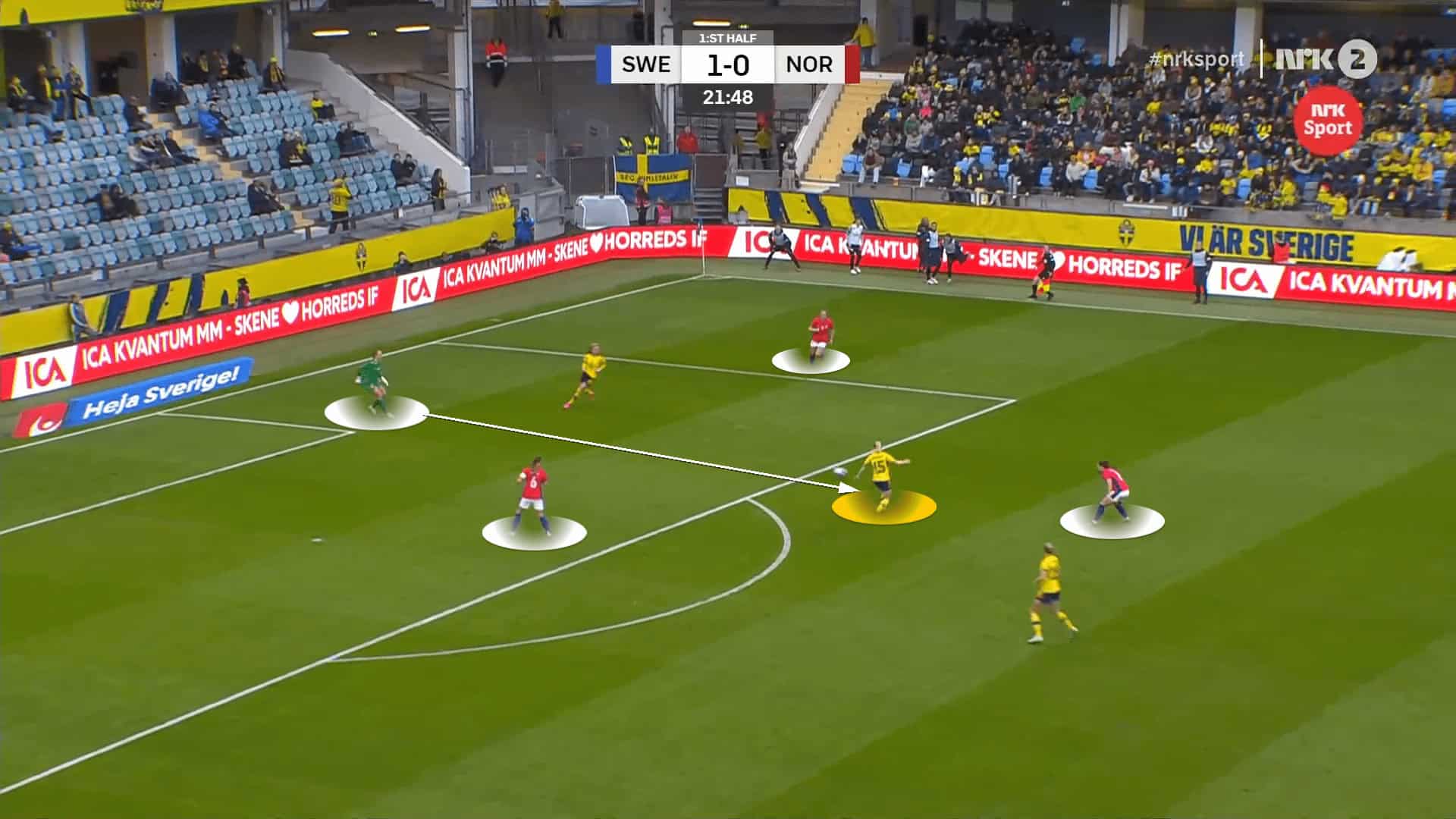
In general, Hege Riise’s team is very aggressive and vertical in possession. They have developed very good concepts to progress and attack quickly, but they could control games much better with more composure in their play, taking more advantage of restarts and shorter distances in their midfield, using wingers in width frequently not only to go deep but also to make the opposing block move and create space inside that will be useful for attacking.
Defensive phase
Riise’s Norway is a team that vary considerably in their defensive approach depending on the opponents they face. According to the opponent’s game plan, they can press high with a lot of intensity but also work in a medium-low block with short distances between all their lines. In addition, the coordination of the off-the-ball block is remarkable depending on their approach.
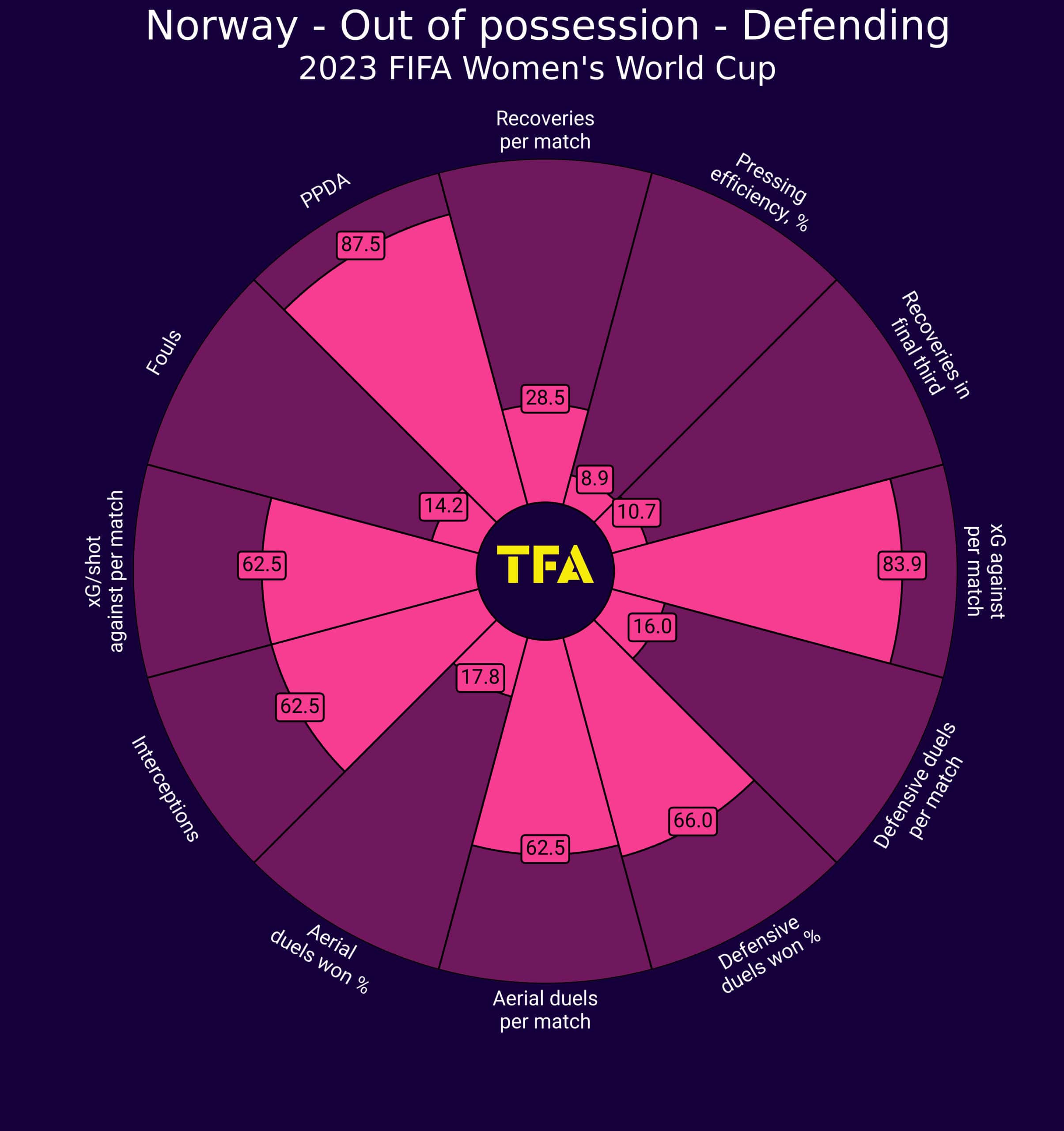
Most of the teams they have faced in recent months did not have the ability to exploit advantages from the build-up phase, which is why the team focused on high and very intense pressure. The man-marking is usually quite accurate and, in general, the players have dominated good concepts such as timing their runs and trajectories to reduce the opponents’ options for progression.
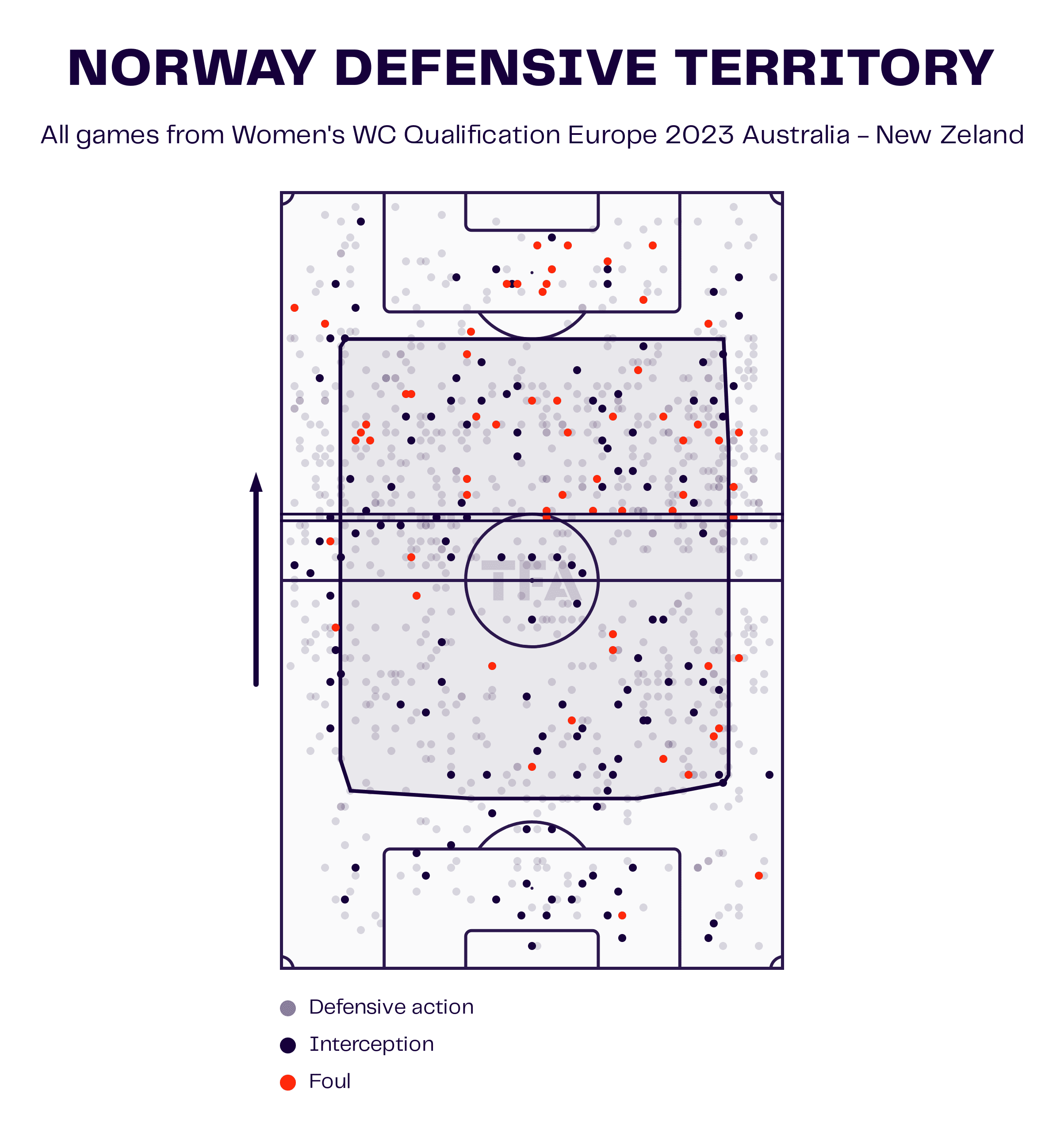
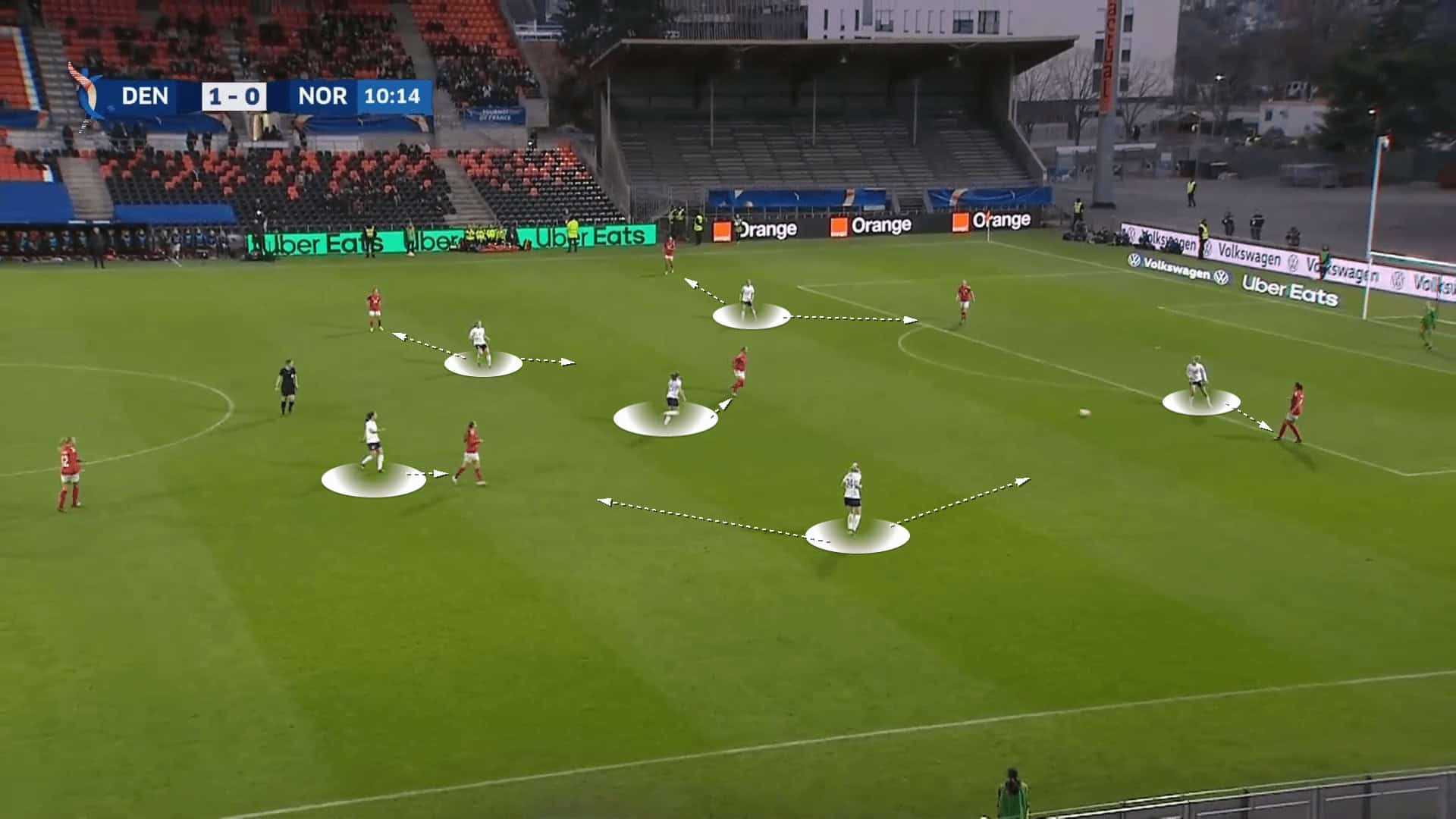
The energy with which Norway presses is also remarkable. This is a very intense exercise and one that they manage to keep energetic as the minutes go by, which is why they are very effective in this respect when they focus on stealing in the opposition half or forcing their opponents to make mistakes or make unsuccessful long passes.
However, against teams who are much more dominant through possession and much better at attracting pressure in the build-up phase with the aim of making progress behind each opposition line, Norway opt for a more conservative approach in a low-mid block. During one of the last pre-World Cup friendlies, against Sweden, Riise’s team worked for much of the first half with a tight mid-low block and short distances between each of their lines.
In this way, they do not allow their opponents to progress inside, but instead look to do so on the outside, where superiority is eliminated with 1v1 duels and more time to make relays to the back of the overrun player.
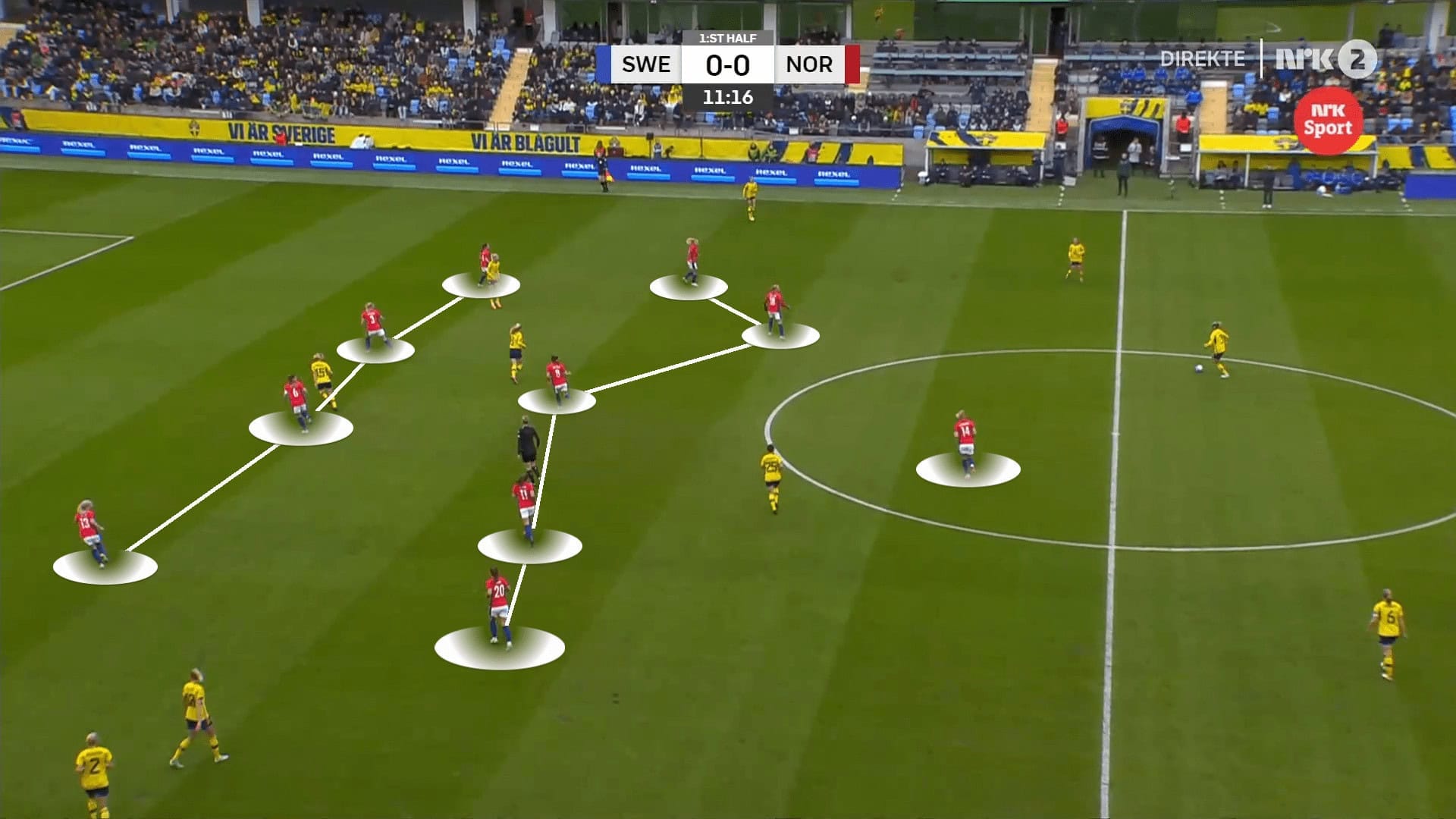
Riise is a coach who designs very good match plans for her opponents, especially in her team’s off-the-ball approach and the adjustments she makes during the match to create unfavourable scenarios for her opponents.
Transitions
Norway’s attacking transitions are usually very aggressive, being a team that benefits a lot from counterattacks, but it all depends on the zone of the pitch where they win the ball back.
When they regain the ball in the opposition’s half of the pitch, they look to quickly link up with attacking players or directly connect with them in space. Likewise, this also happens when they do it near midfield, especially when Risa gets time and space to exploit her progressive passing range.

One of the reasons why the team can approach games defending in a lower-mid block most of the time is because of their aggressiveness when counterattacking. In addition to the energy that most of the attacking players have, anyone playing as a centre-forward dominates concepts of receiving long passes, holding opponents at their back and then being able to connect or activate players in space. In this sense, the team takes full advantage of the speed of the wingers and even some central midfielders, as is the case with Maanum when attacking space in the opposition half of the pitch.
In defensive transitions, the team’s approach varies according to the game plan. When looking to defend high, the team is very intense in its counterpressure and seeks to steal the ball in the opposition half as quickly as possible. However, when it comes to much more possession-dominant teams, Norway tends to be a much more orderly and conservative team that quickly forms a low-mid block to defend.
In this respect, it is very noticeable how the team’s forwards often put in a lot of physical effort trying to put pressure on the ball-holder while their teammates a few metres behind them organise themselves. In general, the movements tend to be quick and well-coordinated.
Attackers
Norway possess many talented attacking players. In addition, among the variety of profiles, most of the players are quick, energetic and tactically intelligent to exploit advantages in the opposition half and work in a coordinated way with the block when defending.
Ada Hegerberg is of great importance in the team as the number nine, especially due to her self-sufficiency when she is in good form and how she can activate close-up players through her link-up play and dynamising attacks through third-man concepts. Also, Guro Reiten is key in the game idea, being able to play wide, but having a lot of influence inside, and Graham Hansen has a great technical ability that allows her to be very important on the wing, beating opponents in 1v1 and attacking space.
Midfielders
In the middle of the pitch, Norway have a variety of profiles to implement their ideas. In general, they are players with very aggressive intentions. In this way, the presence of Vilde Bøe Risa is key, as she is in charge of controlling the tempo of the game and distributing. While she is a player with a great range of progressive passing range, she also excels in her selection to maintain possession.
Frida Maanum is a very dynamic player who shines in a role that allows her to get into the opposition box frequently. She can create or finish many dangerous chances. Haavi can play a similar role and is also positionally flexible.
Defenders
The defensive line is made up of players with good defensive concepts in general, capable of playing in a high defence, but also adapting to a lower-middle block with different roles.
Players like Hansen, Mjelde and Lund stand out for their experience, while others like Harviken are much younger, but have shown a very interesting level over the last few months. They are not particularly brilliant players to progress with the ball, but they can contribute to their team’s possessions when they need to, either through short passes or good mobility to offer themselves as a restart option.
Key player

Norway have many important players in great form, but our choice for the key player is Guro Reiten for all that she brings to the team. She comes into the tournament after a great season with Chelsea, being the top assist-provider in the WSL (11 assists) and can be very productive in attack, either creating or finishing scoring chances.
She is also a flexible positional player. She can start on the wing, but also focus on playing on the inside and dynamise the game from there. Her influence will undoubtedly be key to everything the team can achieve during this tournament.
Tournament prediction
Because of Norway’s potential and experience, they are a team with the level to win the title. Their performance during the qualification for the Women’s World Cup 2023 was very good, without losing once. In addition, they have a very balanced team in each of their lines between very experienced players at the top level and other young players with a lot to contribute.
It is an intense tournament and Norway have several tactical details to improve in order to be a more imposing team. However, their ability to adapt to different opponents makes them a very difficult team to play against and especially to beat.





Comments